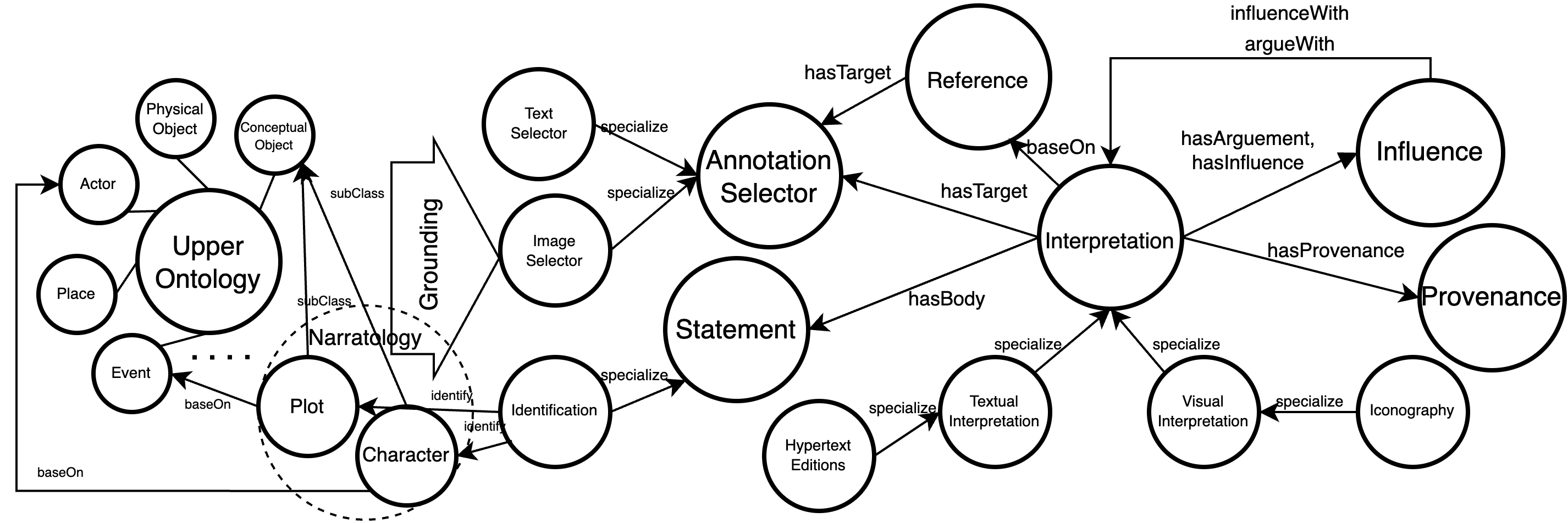3. Our Objective and Method
To capture the extensive network of iconographical, historical, and cultural connections of intricate visual content, we propose a deep semantic annotation approach for data curation down to Point of Interest (POI) level. Our objective is to introduce a semantic annotation platform for, but not limited to, intricate visual content. Harnessing Linked Open Data (LOD) technologies, POI-based annotation can be summarized into three levels,
| Level | Description | Usage | Related Software / Paper |
| Semantic Subject indexing | Tag controlled LOD vocabularies to a POI | Image retrieval | (Rainer 2023) |
| Semantic Annotation | Assign LOD resources to a POI with a predicate (e.g. dc:subject, dcterms:references) | Faceted image retrieval | (Clarke 2015; Loh 2017) |
| Deep Semantic Annotation | Assign knowledge graphs to a POI with an ontology | Inference and reasoning with SPARQL | (Wang et al. 2021) |
Table 1. Three levels POI-based Annotation
Scholarly interpretation is a nuanced process which encompasses multiple levels of conceptualization, aggregation of observations and evidence, and formation of interpretative statements using domain-specific terminology. Building a competent system for scholarly annotation demands the system to attain the deep semantic annotation level mentioned above. This involves two stages. Firstly, to characterize the visual scholarly domain and formalize an ontology to support fine-grained scholarly annotation. Secondly, choosing appropriate technologies for developing the annotation platform, supported by user study to validate the system's efficacy.
Supported by the Knowledge Graph Management Platform (KGMP), the primary objective of the semantic annotation platform is to function as a comprehensive knowledge base. This knowledge base will facilitate the accumulation of scholarly interpretations along with their corresponding evidence.
The proposed annotation ontology comprises the following components:
• Interpretation components: We will work with domain experts from various disciplines to identify alignment paths for specializing ontologies, if any are drawn.
• Influence, Provenance and Reference: Provides a semantic representation of the digital scholarly annotation in the humanities.
• Annotation Selector: This component links to the digital representation or citation of the annotated object or the sources/theories supporting the annotation.
• Upper Ontology: Provides alignments of key classes and properties to upper ontology.
• Narratology: Combines conceptual objects, events, and actors to provide ontological grounding for plots and characters. It serves as the knowledge model to disentangle historical events from the plots depicted in the visual content.

Figure 1. High-level ontology network view of the proposed annotation ontology
This paper will report the current progress of the annotation ontology, Our formalization process employs a diverse range of methods. Domain characterization relies on grounded evidence to identify the key notion to be modelled and addressed in the ontology. The reuse of existing ontologies fosters interoperability, building upon prior critical efforts in formalization (Azzi et al. 2019; Carriero et al. 2021). The formalization process also references a collection of ontology design methods, such as SAMOD (Peroni 2016), ontology network (Gómez-Pérez / Suárez-Figueroa 2009), ontology design pattern (ODP) (Gangemi / Presutti 2009) and modular design (Shimizu et al. 2020).

Figure 2. Selected grounded evidence for bottom-up ontology modeling